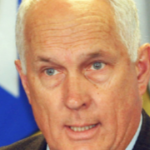Houston began his week in office pressing (yet another) reset on our healthcare mess. He ended it needing to press reset on his relations with the province’s African Nova Scotian community.

So, let’s begin this history lesson somewhere in the murky middle muddle, way back in 1994 when a fresh-faced Liberal government led by Dr. John Savage began the process of regionalizing Nova Scotia’s local health authorities because… well, because everyone else was doing it, and because some experts said it would save money.
Then fast forward five years to the next new Conservative government led by another doctor, John Hamm. Hamm took Savage’s four regional health authorities, doubled them and added one more for good measure, making a total of nine district health authorities or DHAs. Count ’em. If four could save taxpayers money, he seemed to say, think how much more nine could save.
None of them actually did.
As researcher Katherine Fierlbeck noted in 2019 in Volume 7, Issue 3, Article 3 of the Health Reform Observer, “the expected cost savings of regionalized health governance never did materialize.”
Undaunted and undeterred, another new Liberal government came to power in 2013, this one led by Stephen McNeil, a TV repairman instead of a doctor. Following the lead of Alberta’s right-wing government, McNeil decided he would seek the future of healthcare by reverse-engineering the expansion of its bureaucracy. He mashed our multiple health authorities into one. To save even more money.
Allow me to introduce the success of the new Nova Scotia Health Authority (NSHA). Fierlbeck again:
Five years after the event, what has been the effect of reorganization of the DHAs into a single health authority? One primary objective was the containment of health care costs. Overall, however, health care expenditure in Nova Scotia has steadily increased from $4,393.5M in 2013 to a projection of $4,814.4M in 2018.
Moreover, the percentage of provincial government expenditure used only for health administration in 2018-19 is projected to be 1.3 per cent, exactly what it was in 2013-14, the year before the NSHA was established…
A more subtle issue is the extent to which administrative costs were the result of the number of highly paid administrators. CEO positions for the DHAs were eliminated under amalgamation, but were replaced by a wide array of VPs, Chiefs, and Executive Directors for the consolidated NSHA.
Beyond all the money that wasn’t saved, McNeil’s new one-size-fits-all health authority also failed to deliver on its corollary promise of better health care. In 2017, a group of medical professionals issued “a scathing report” on its operations, “saying the organization isn’t agile enough to respond to local needs and is subject to political interference.”
The Cliff’s Notes version? One health authority didn’t work any better than four or nine. Perhaps the number of health authorities was not the real problem.
Which brings us to last week and Day 2 of 1,459 to come under yet another new Progressive Conservative premier, this one an accountant named Tim Houston. In his first major decision as premier, Houston fired the CEO and the entire board of the Nova Scotia Health Authority, replacing them with a new four-person leadership team, whose interim leader, Karen Oldfield, appears to be more comfortable in Tory backrooms than operating rooms.
“I’ve said all along that transformational change was needed to improve healthcare and it starts today,” declared Houston, whose winning electoral strategy had indeed focused almost exclusively on fixing healthcare. “We’ve put an experienced team in place with a mandate to listen, make decisions and take quick action. They will remove the barriers that are getting in the way of change and providing better health care to Nova Scotians.”
But will this latest transformational change, this reset, these new brooms clean up the mess that everyone agrees our healthcare system has become?
On the plus side, Houston has made it clear his goal is not to save money, that he knows he will need to spend more to make the system deliver better for Nova Scotians. That’s a good start.
On the flip side, however, Houston’s new team is made up of the politically connected Oldfield and three experienced — perhaps too experienced — healthcare bureaucrats.
Where are the system’s frontline workers? The nurses, ER doctors, paramedics, orderlies, care workers? They will get their chance to have input, Houston seemed to suggest, during a four-day show tour later this month featuring the premier, Health Minister Michelle Thompson and their new leadership team. They will listen to frontline workers, but will they actually hear them, given that they still have no seat at the table?
Speaking of seats at the table, Houston’s decision to fire the entire board also meant the loss of only recently appointed Black and Indigenous representatives to that board.
What does that say about Houston’s commitment to diversity?
What did the rest of Houston’s first week?

On Tuesday, Houston unveiled his new cabinet, naming Pat Dunn, a 71-year-old white male, as the minister of both African Nova Scotian Affairs and the Office of Equity and Anti-Racism Initiatives.
The next day, Houston fired a Black senior civil servant, Dr. Késa Munroe-Anderson, who had been deputy minister of both African Nova Scotian Affairs and the Department of Communities, Culture and Heritage, replacing her with a white male deputy.
“We made changes to a number of deputies,” Houston said in bland response to criticism from many in the Black and other communities. “We have a vision for the province… And we thought we were [acting] in the best interests, executing on the vision.”
Does Houston’s vision include our Black and indigenous citizens?
To be fair, Houston was in a difficult place when it came to appointing his minister of African Nova Scotian Affairs. He claimed his party had run “the most diverse slate of candidates that the party had ever run.” Which wasn’t saying a lot. But even then the reality was that none of the three Black candidates who ran for the PCs won.
For good reasons — do we really want Houston appointing an unelected developer like Scott McCrea as his minister of housing? — parliamentary tradition dictates that ministers need to be elected so they can be accountable to the legislature, both individually as the minister of a department and collectively as ministers in the government.
While governments will occasionally parachute in an unelected individual to fulfill a particular gap or need, it is almost always temporary. The appointed minister is expected to run in a by-election as soon as possible. Presuming Houston could persuade one of his MLAs to step aside to open a seat, would his anointed candidate win? And what would happen if they didn’t?
There was another option, of course. We don’t know if Houston reached out to any of the four opposition Black MLAs elected in last month’s election to ask if they would be willing to switch sides and serve in his cabinet. That, of course, would create complications of its own for both parties, but there is no indication Houston even considered the option.
It seems he didn’t look for any innovative solutions to what is clearly a problem for him and his new government in a world that has changed dramatically since the PCs were last in power.
“Nova Scotians made their decisions on who they wanted as their MLAs,” Houston declared. “I respect their decisions. But as premier, the final responsibility rests with me with the ministers that we put in place.” And the premier had a message for those in a Black community who would not have a seat at his cabinet table, “I don’t want [there] to be any confusion. My message to them: we respect you, we will listen to you, we will work with you, your voice will be heard.”
There is, unfortunately, already confusion. And consternation. And frustration. By getting rid of the diverse voices on his health board, by firing one of the government’s too few senior Black civil servants, by appointing a white man to head the one department whose primary focus is African Nova Scotian affairs — and all of that in his first week in office — Premier Houston is sending a very different message than the one he proclaimed.
A version of this column originally appeared in the Halifax Examiner.
To read the latest column, please subscribe.




 STEPHEN KIMBER, a Professor of Journalism at the University of King's College in Halifax and co-founder of its MFA in Creative Nonfiction Program, is an award-winning writer, editor and broadcaster. He is the author of two novels and eight non-fiction books. Buy his books
STEPHEN KIMBER, a Professor of Journalism at the University of King's College in Halifax and co-founder of its MFA in Creative Nonfiction Program, is an award-winning writer, editor and broadcaster. He is the author of two novels and eight non-fiction books. Buy his books
Hello,
The Liberal’s move to merge health care into one authority instead of nine did not come from Alberta. It came from my health care blog. In February 2013, before the election was called, the then Opposition Leader and Opposition Health Critic met with me in the Tan Coffee Shop in Wolfville to discuss my ideas and what a future health authority would look like.
The idea was never to save money, but to refocus savings on executive salaries, costs and perks to front-line care. As for how much money is needed to fix health care – no one knows. I’ve been asking that question since 20120. No one from any political party or health care executive suites can say. One thing study after study have found is that more money for health care makes solutions more expensive.
The failure of the NSHA is that we developed a new structure for delivery but installed old thinkers to run it. Janet Knox has a long-term history of higher -than-standard administration costs. When she ran the Annapolis Valley District Health Authority their administrative costs were 3.8% above the national average.
I don’t believe the NSHA idea has been a failure. The failure is one of management. We have re-organized health care three times in 30 years and same issue persist. That is a management failure. Yet, politicians are afraid of health executives. The new Premier was right to fire the CEO and Board.